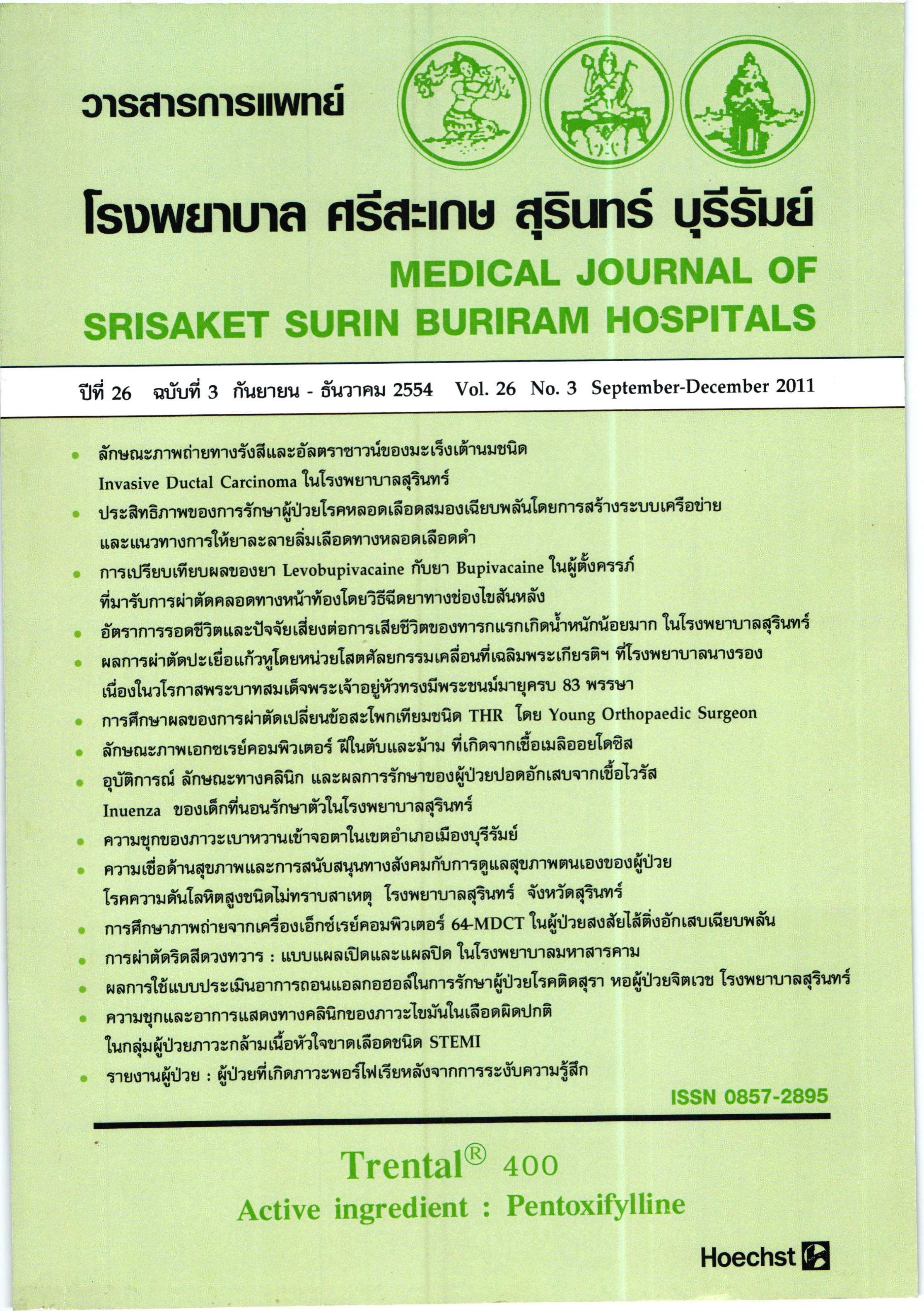อัตราการรอดชีวิตและปัจจัยเสี่ยงต่อการเสียชีวิตของทารกแรกเกิดน้ำหนักน้อยมากในโรงพยาบาลสุรินทร์
Main Article Content
บทคัดย่อ
หลักการและเหตุผล: ในช่วงระยะเวลาหลายสิบปีที่ผ่านมา ได้มีวิวัฒนาการในด้านการพัฒนาระบบการ ดูแลทารกแรกเกิดน้ำหนักน้อยมาก ส่งผลให้อัตราการรอดชีวิตเพิ่มขึ้น ซึ่งการดูแลทารกใน กลุ่มนี้นั้น ต้องใช้ทรัพยากรและงบประมาณในการดูแลค่อนข้างสูง นอกจากนี้ ทารกส่วนหนึ่งยังเกิดภาวะแทรกซ้อนที่รุนแรง และ ภาวะทุพพลภาพเรื้อรังในระยะยาวตามมาภายหลัง จากการรักษาทางกลุ่มงานกุมารเวชกรรมได้พัฒนาศักยภาพการดูแลทารกในกลุ่มนี้อย่างต่อเนื่อง จึงต้องการฐานข้อมูลเพื่อนำไปพัฒนาเครือข่ายระบบการดูแลทารกแรกเกิดน้ำหนักน้อยให้มีประสิทธิภาพมากยิ่งขึ้น
วัตถุประสงค์: เพื่อศึกษาอัตราการรอดชีวิตและปัจจัยเสี่ยงต่อการเสียชีวิตของทารกแรกเกิดน้ำหนักน้อยมากในโรงพยาบาลสุรินทร์
รูปแบบการวิจัย: เป็นการศึกษาแบบย้อนหลัง(Retrospective analytical study)
วิธีการวิจัย: เก็บรวบรวมข้อมูลจากเวชระเบียนผู้ป่วยนอกและในของทารกแรกเกิดน้ำหนักน้อยมากทุกราย ที่เข้ารับการรักษาในโรงพยาบาลสุรินทร์ ระหว่าง วันที่ 1 ตุลาคม 2551 ถึง 30 กันยายน 2553 ตั้งแต่แรกเกิดจนถึงจำหน่ายกลับบ้าน หรือเสียชีวิต ข้อมูลประวัติมารดา และการคลอดรวบรวมจากใบบันทึกการคลอดของกลุ่มงานสูติ-นรีเวชกรรม
ผลการศึกษา: จำนวนทารกในการศึกษา 157 ราย มีอัตราการรอดชีวิตของทารกแรกเกิดน้ำหนัก <1,500 กรัม (VLBW) ร้อยละ 66.2 (104/157) และทารกแรกเกิดน้ำหนัก <1,000 กรัม (ELBW) ร้อยละ 36.4 (20/55) สาเหตุการเสียชีวิตมากที่สุดคือ RDS (ร้อยละ58.5), Sepsis (ร้อยละ20.8), Pneumonia (ร้อยละ9.4), Immaturity (ร้อยละ5.7), Severe birth asphyxia (ร้อยละ3.8), Congestive heart failure (ร้อยละ1.9) ปัจจัยเสี่ยงที่มีผลต่อการเสียชีวิต อย่างมีนัยสำคัญทางสถิติ (p<0.05) คือ ทารกแรกเกิดน้ำหนักน้อยกว่า 1,000 กรัม (p=0.000), อายุครรภ์ที่ 28 สัปดาห์ (p=0.000), Apgar score ที่ 1นาที <5 (p=0.008), Apgar score ที่ 5 นาที <5 (p=0.003), อุณหภูมิกายแรกรับ <36.50 เซลเซียส (p=0.023) และ การต้องใส่ท่อช่วยหายใจเพื่อการกู้ชีพในห้องคลอด (p=0.000)
สรุป: อัตราการรอดชีวิตของทารกแรกเกิดน้ำหนักน้อยมาก (VLBW) ใกล้เคียงกับการศึกษาอื่น
ในประเทศ แต่ยังคงมีอัตราการรอดชีวิตตอยู่เมื่อเทียบกับการศึกษาในต่างประเทศ ปัจจัยเสี่ยงที่มีผลต่อการเสียชีวิตอย่างมีนัยสำคัญทางสถิติได้แก่ ทารกแรกเกิดน้ำหนักน้อยกว่า 1,000 กรัม, อายุครรภ์ที่ 28 สัปดาห์, APGAR score 1และ5 นาที <5, อุณหภูมิกาย แรกรับ <36.5° เซลเซียส และ การต้องใส่ท่อช่วยหายใจเพื่อการกู้ชีพในห้องคลอด ซึ่งผลการศึกษานี้จะนำไปสู่การพัฒนาระบบคุณภาพการดูแลผู้ป่วยต่อไป
Article Details
References
Courtney SE, Duran DJ, Asselin JM. et al. High-Fre-quency Oscillatory Ventilation versus Conventional Mechanical Ventila- tionfor Very-Low-Birth--Weight Infants. N Eng J Med 2002;347:643-52.
Shankaran S, Fanaroff AA, Writht LL, et al. Risk factors for early death among extremely low-birth-weight infants. Am J Obstet Gynecol 2002; 186:796-802.
Engle WA; American Academy of Pediatrics, Committee on Fetus and Newborn. Surfactant-replacement therapy for respiratory distress in the preterm and term neonate. Pediatrics 2008; 121:419-32.
Eichenwald EC, Stark AR. Management and Outcomes of Very Low Birth Weight. N Engl J Med 2008;358:1700-11.
Behrman RE, Stith Butler A, eds. Preterm birth: causes, consequences, and pre- vention.Washington, DC: National Academies Press; 2007.
Fanaroff AA, Stoll BJ, Wright LL, et al.Trends in neonatal morbidity and mortality for very low birthweight infants. Am J Obstet Gynecol 2007; 196:2:147.el-147.e8.
Neil Marlow, Dieter Wolke, Melanie A, et al. Neurologic and Developmental Disability at Six Years of Age after Extremely Preterm Birth. N Engl J Med 2005;352:9-19.
Kliegman RM : Neonatal necrotizing enterocolitis :bridging the basic science with the clinical diseasej Pediatr 1990;117:836.
Garner A : International classification of retinopathy of prematurity. Pediatrics 1984;74:127.
Flack M, Fanaroff AA, Outcomes of children of extremely low birth weight and gestational age in the 1990s. Semin Neonatal 2000; 5:2:89-106.
Tsou Kl, Tsao PN. The morbidity and survival of Very-low-birth-weight infants in Taiwan. Acta Paediatr Taiwan. 2003; 44 :349-55.
Crowley P. Prophylactic corticosteroids for preterm birth. Cochrane Database Syst Rev 2006;3:CD000065.
American Academy of Pediatrics, Committee on Fetus and Newborn. Postnatal corticosteroids to treat or prevent chronic lung disease in preterm infants. Pediatrics 2002; 109: 330-8.
Miksch R, Armbrust S, Pahnke J, Fusch C. Outcome of very low birth weight infants after introducing a new standard regimen with the early use of nasal CPAP. Eur J Pediatric 2008; 167: 909-16.
Thaithumyanon P, Punnahitananda S. Neonatal mortality and morbidity of very low birth weight infants at King Chulalongkorn Memorial Hospital. Chula Med J 2008; 52: 255-64.
Forsblad K, Kallen K, Marsal K, Hell- strom-Westas L. Apgar score predicts short-term outcome in infants born at 25 gestational weeks. Acta Paediatr. 2007; 96:166-71.
Thorngren-Jerneck K, Herbst A. Low 5 minute APGAR score: a population-base register study of 1 million term births. Obstet Gynecol 2001; 98:1: 65-70.
Basu S, Rathore P, Bhatia BD. Predictors of mortality in very low birth weight neonates in India. Singapore medical journal 2008; 49: 556-60.
Laptook AR, Salhab W, Bhaskar B. Admission temperature of low birth weight infants: predictors and associated morbidities. Pediatrics 2007; 119:e643-9.

